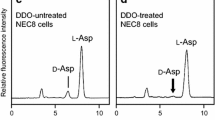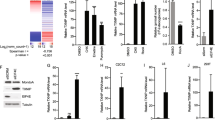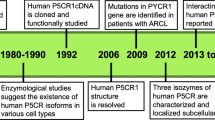Abstract
Mammalian Δ1-pyrroline-5-carboxylate synthase (P5CS) is a bifunctional ATP- and NAD(P)H-dependent mitochondrial enzyme that catalyzes the coupled phosphorylation and reduction-conversion of l-glutamate to P5C, a pivotal step in the biosynthesis of l-proline, l-ornithine and l-arginine. Previously, we reported cloning and characterization of two P5CS transcript variants generated by exon sliding that encode two protein isoforms differing only by a two amino acid-insert at the N-terminus of the γ-glutamyl kinase active site. The short form (P5CS.short) is highly expressed in the gut and is inhibited by ornithine. In contrast, the long form (P5CS.long) is expressed ubiquitously and is insensitive to ornithine. Interestingly, we found that all the established human cell lines we have studied expressed P5CS.long but not P5CS.short. In addition, expression of P5CS.long can be modulated by hormones: downregulation by hydrocortisone and dexamethasone and upregulation by estradiol, for example. Using a quantitative proteomic approach, we showed that P5CS.long is upregulated by p53 in p53-induced apoptosis in DLD-1 colorectal cancer cells. Functional genomic analysis confirmed that there are two p53-binding consensus sequences in the promoter region and in the intron 1 of the human P5CS gene. Interestingly, overexpression of P5CS by adenoviruses harboring P5CS.long or P5CS.short in various cell types has no effect on cell growth or survival. It would be of importance to further investigate the role of P5CS as a p53 downstream effector and how P5CS.short expression is regulated by hormones and factors of alternative splicing in cells isolated from model animals.





Similar content being viewed by others
References
Adhani VM, Ahmad N, Kukhtar H (2003) Molecular targets for green tea in prostate cancer prevention. J Nutr 133:2417S–2424S
Adams E, Frank L (1980) Metabolism of proline and the hydroxyproline. Annu Rev Biochem 49:1005–1061
Aral B, Schlenzig JS, Liu G, Kamoun P (1996) Database cloning human delta 1-pyrroline-5-carboxylate synthetase (P5CS) cDNA: a bifunctional enzyme catalyzing the first 2 steps in proline biosynthesis. C R Acad Sci III 319:171–178
Baumgartner MR, Aral B, Rabier D, Kamoun P, Valle D, Saudubray J-M (2005) Hyperammonemia with reduced ornithine, citrulline, arginine and proline: a new inborn error caused by a mutation in the gene encoding delta-1-pyrroline-5-carboxylate synthase. Eur J Pediatr 164:31–36
Baumgartner MR, Hu CAA, Almashanu S, Steel G, Obie C, Aral B, Rabier D, Kamoun P, Saudubray J-M, Valle D (2000) Hyperammonemia with reduced ornithine, citrulline, arginine and proline: a new inborn error caused by a mutation in the gene encoding delta-1-pyrroline-5-carboxylate synthase. Hum Mol Gen 9:2853–2858
Flynn NE, Wu G (2003) Regulation of intestinal amino acid metabolism by glucocorticoids. Recent Res Dev Physiol 1:169–178
Gu S, Liu Z, Pan S, Jiang Z, Lu H, Amit O, Bradbury EM, Hu CAA, Chen X (2004) Global investigation of p53-induced apoptosis through quantitative proteomic profiling using comparative amino acid-coded tagging. Mol Cell Proteomics 3:998–1008
Hagedorn CH, Phang JM (1983) Transfer of reducing equivalents into mitochondria by the interconversions of proline and Δ1-pyrroline-5-carboxylate. Arch Biochem Biophys 225:95–101
Hu CAA, Delauney A, Verma DPS (1992) A bifunctional enzyme (Δ1 -pyrroline-5-carboxylate synthetase) catalyzes the first two steps in proline biosynthesis. Proc Natl Acad Sci USA 89:9354–9358
Hu CAA, Lin WW, Valle D (1996) Cloning, characterization and expression of cDNAs encoding human Δ1-pyrroline-5-carboxylate dehydrogenase. J Biol Chem 271:9795–9800
Hu CAA, Lin WW, Obie C, Valle D (1999) Molecular enzymology of mammalian delta1-pyrroline-5-carboxylate synthase. Alternative splice donor utilization generates isoforms with different sensitivity to ornithine inhibition. J Biol Chem 274:6754–6762
Hu CAA, Donald SP, Yu J, Lin WW, Liu Z, Steel G, Valle D, Phang JM (2007) Overexpression of proline oxidase induces proline-dependent and mitochondria-mediated apoptosis. Mol Cell Biochem 295:85–92
Johnson TM, Yu ZX, Ferrans VJ, Lowenstein RA, Finkel T (1996) Reactive oxygen species are downstream mediators of p53-dependent apoptosis. Proc Natl Acad Sci USA 93:1848–1852
Kamoun P, Aral B, Saudubray JM (1998) A new inherited metabolic disease: delta-1-pyrroline 5-carboxylate synthetase deficiency. Bull Nat Acad Med 182:131–139
Liu Z, Lu H, Jiang Z, Pastuszyn A, Hu CAA (2005a) Apolipoprotein L6, a novel proapoptotic Bcl-2 homology 3-only protein, induces mitochondria-mediated apoptosis in cancer cells. Mol Cancer Res 3:21–31
Liu Z, Lu H, Shi H, Du Y, Yu J, Gu S, Chen X, Hu CAA (2005b) PUMA overexpression induces reactive oxygen species generation and proteasome-mediated stathmin degradation in colorectal cancer cells. Cancer Res 65:1647–1654
Liu Y, Borchert GL, Surazynski A, Hu CA, Phang JM (2006) Proline oxidase activates both intrinsic and extrinsic pathways for apoptosis: the role of ROS/superoxides, NFAT and MEK/ERK signaling. Oncogene 25:5640–5647
Liu Z, Wan G, Heaphy C, Bisoffi M, Griffith JK, Hu CA (2007) A novel loss-of-function mutation in TP53 in an endometrial cancer cell line and uterine papillary serous carcinoma model. Mol Cell Biochem 297:179–187
Morris SM (2002) Regulation of enzymes of the urea cycle and arginine metabolism. Annu Rev Nutr 22:87–105
Morris SM, Moncman CL, Rand KD, Dizikes GJ, Cederbaum SD, O’Brien WE (1987) Regulation of mRNA levels for five urea cycle enzymes in rat liver by diet, cyclic AMP, and glucocorticoids. Arch Biochem Biophys 256:343–353
Norgen S, Li L-S, Luthman H (1984) Regulation of human insulin receptor RNA splicing in HepG2 cells: effects of glucocorticoid and low glucose concentration. Biochem Biophy Res Comm 199:277–284
Phang JM (1985) The regulatory functions of proline and pyrroline-5-carboxylic acid. Curr Topics Cell Regul 25:91–132
Phang JM, Hu CA, Valle D (2001) Disorders of proline and hydroxyproline metabolism. In: Scriver CR, Beaudet AL, Sly WS, Valle D (eds) Metabolic and molecular basis of inherited disease. McGraw Hill Press, New York, pp 1821–1838
Polyak K, Xia Y, Zweier JL, Kinzler KW, Vogelstein B (1997) A model for p53-induced apoptosis. Nature 389:300–305
Rabier D, Nuttin C, Poggi F, Padovani JP, Abdo K, Bardet J, Parvy P, Kamoun P, Saudubray JM (1992) Familial joint hyperlaxity, skin hyperelasticity, cataract and mental retardation with hyperammonemia and low citrulline, ornithine and proline: a new disorder of collagen metabolism? In: Abstracts of free communications, 30th annual symposium Leuven, September 8–11, 1992. The Society for the Study of Inborn Errors of Metabolism (SSIEM), Leuven, Note: p 61
Tadros SF, D’Souza M, Zettel ML, Zhu X, Waxmonsky NC, Frisina RD (2007) Glutamate-related gene expression changes with age in the mouse auditory midbrain. Brain Res 1127:1–9
Ulbright C, Snodgrass PJ (1993) Coordinate induction of the urea cycle enzymes by glucagon and dexamethasone is accomplished by three different mechanisms. Arch Biochem Biophys 301:237–243
Valle D, Simell O (2001) Hyperornithinemias. In: Scriver CR, Beaudet AL, Sly WS, Valle D (eds) Metabolic and molecular basis of inherited disease. McGraw Hill Press, New York, pp 1857–1895
Vasiliou V, Bairoch A, Tipton KF, Nebert DW (1999) Eukaryotic aldehyde dehydrogenase (ALDH) genes: human polymorphisms, and recommended nomenclature based on divergent evolution and chromosomal mapping. Pharmacogenetics 9:421–434
Vogelstein B, Lane D, Levine AJ (2000) Surfing the p53 network. Nature 408:307–310
Vousden KH, Prives C (2005) P53 and prognosis: new insights and further complexity. Cell 120:7–10
Vousden KH, Lu X (2002) Live or let die: the cell’s response to p53. Nat Rev Cancer 2:594–604
Wang T, Milam AH, Steel G, Valle D (1996) A mouse model of gyrate atrophy of the choroid and retina. Early retinal pigment epithelium damage and progressive retinal degeneration. J Clin Invest 97:2753–2762
Wu G, Knabe DA (1995) Arginine synthesis in enterocytes of neonatal pigs. Comp Physiol 269:R621–629
Wu G, Meininger CJ, Kelly K, Watford M, Morris Jr SM (2000) A cortisol surge mediates the enhanced expression of pig intestinal pyrrolinee-5-carboxylate synthesis during weaning. J Nutr 130:1914–1919
Wu G, Morris SM (1998) Arginine metabolism: nitric oxide and beyond. Biochem J 336:1–17
Yoon K-A, Nakamura Y, Arakama H (2004) Identification of ALDH4 as a p53-inducible gene and its protective role in cellular stresses. J Hum Genet 49:134–140
Acknowledgments
This work is supported by NM-INBRE grant (2 P20 RR016480-04), DOD PCRP (#W81XWH-05-1-0357) and NCI-RO1 (5RO1 CA106644) (to Hu CAA) and Howard Hughes Medical Institute (to Valle D).
Author information
Authors and Affiliations
Corresponding author
Rights and permissions
About this article
Cite this article
Hu, CA.A., Khalil, S., Zhaorigetu, S. et al. Human Δ1-pyrroline-5-carboxylate synthase: function and regulation. Amino Acids 35, 665–672 (2008). https://doi.org/10.1007/s00726-008-0075-0
Received:
Accepted:
Published:
Issue Date:
DOI: https://doi.org/10.1007/s00726-008-0075-0




